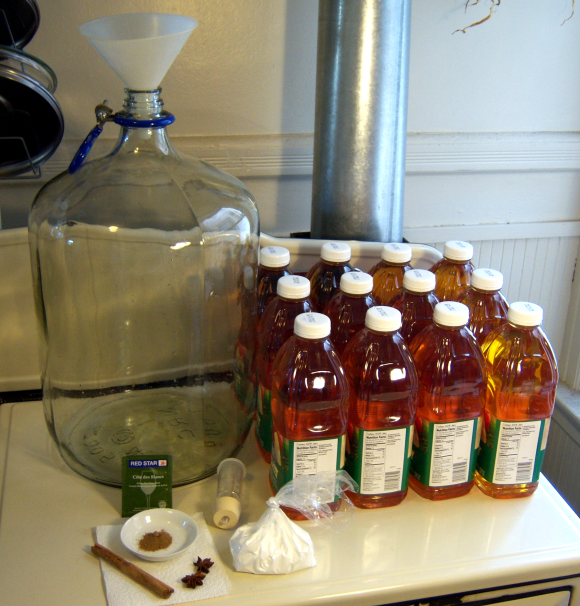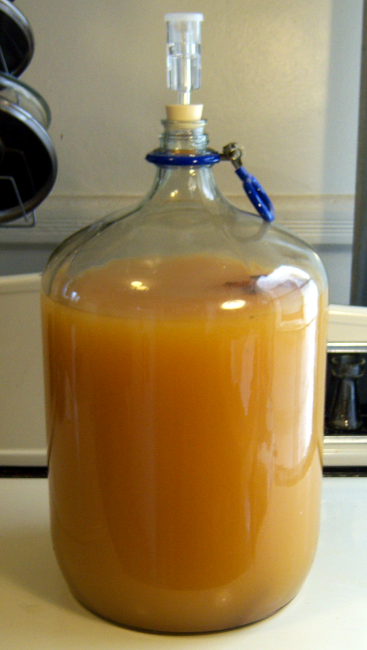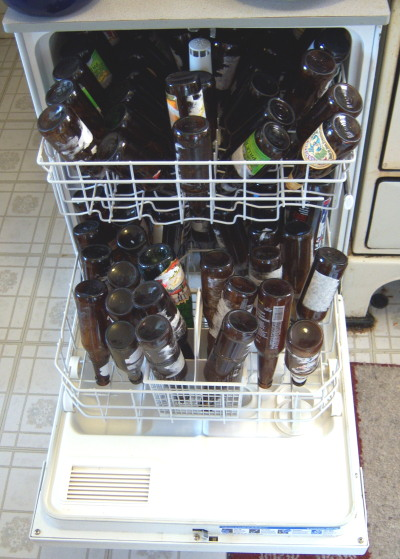Back on I showed you how you can brew your own beer at home. Today I’ll show you how to make hard cider, which is even easier.
All you really need to start with is a fermentation chamber of some sort (I’m using a glass carboy), some wine yeast, and a bunch of apple juice. This should be real juice, not “apple flavored corn syrup beverage” — and pasteurized, not preserved with any chemical preservatives that might prevent the yeast from thriving. The ingredients should be simply “apple juice” or “apple juice concentrate and water” or something like that. Some manufacturers add citric acid as a preservative, and in my experience that doesn’t cause any problems.
If you’re lucky enough to live near an orchard, you can get the juice fresh and unpasteurized from there. My local brewing guru swears that the natural yeast that you’ll find in unpasteurized orchard juice is just exactly the yeast you need to make cider with, so if you do this you don’t need to add yeast — but I haven’t tried this myself enough to vouch for it.
I usually use the cheap stuff, but one time I used some premium apple juice from Martinelli’s and I could sure tell the difference: crisp, dry, delicious cider, with tiny, champagne-like bubbles. Yum!
 My carboy, six gallons of apple juice (it was for some reason cheapest to buy in the 2-quart bottles: $18 for six gallons), an airlock, a bag of priming dextrose, a package of wine yeast, and, (optional) some spices: star anise, cinnamon, and nutmeg.
My carboy, six gallons of apple juice (it was for some reason cheapest to buy in the 2-quart bottles: $18 for six gallons), an airlock, a bag of priming dextrose, a package of wine yeast, and, (optional) some spices: star anise, cinnamon, and nutmeg.
First, clean your fermentation chamber and funnel (I use a mild bleach solution and then rinse with regular tap water until there’s no bleach smell). Then, if you’re going to be fancy, you can optionally boil a handful of spices (I use star anise, nutmeg, and cinnamon) in just enough water to cover for a minute. Add this and the apple juice to your fermentation chamber, pour in the yeast, and pop the airlock on top.
 My work is done… it’s up to the yeast now.
My work is done… it’s up to the yeast now.
Within a couple of days, the apple juice will become cloudy and effervescent and you may notice a sort of “off” smell of rotting fruit bubbling from the airlock. There probably won’t be as much “froth” on top as there is with beer, nor will there be as much sediment falling to the bottom. Some folks insist you should let this process go on for weeks or months, but in my experience, a couple of weeks is usually plenty. In any case, you should wait until things have settled down, the cider is back to looking uncloudy, and the airlock has mostly stopped bubbling. Then from here things proceed to the bottling stage just as with beer.
 The cider becomes more cloudy at the height of fermentation.
The cider becomes more cloudy at the height of fermentation.
First I sterilize enough bottles to hold the cider, using the heated-dry cycle in our dishwasher.
 Sterilizing bottles in the dishwasher
Sterilizing bottles in the dishwasher
I use a special, bottle-filling hose attachment (an inexpensive plastic necessity) to fill the bottles — fifty or more per batch — and then cap them using a hand-me-down stand capper (cappers are less-inexpensive, but also necessary unless you go for self-capping Grolsch-style bottles or the cork-and-cage champagne style caps).
Before bottling, I boil a cup of priming sugar (ordinary dextrose) in a cup of water, cool this, and mix it gently into the cider (trying to distribute it throughout without stirring up the sediment too much). This extra sugar gives the yeast a little something more to work on while the cider is in the bottles, causing enough additional fermentation to carbonate the cider.
 I use a hand-me-down stand capper to bottle my cider.
I use a hand-me-down stand capper to bottle my cider.
Then it’s about a two or three week wait before it’s ready to drink. That’s it.
